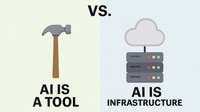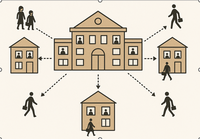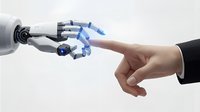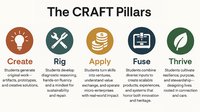Education has always been fertile ground for innovation. From redesigned classrooms to digital platforms, reformers continually search for new ways to reach every child. Too often, change is focused on surface structures—writing Individual Education Plans (IEPs), offering alternative programs, trendy curriculum packages, or technology tools—while the deeper architecture of learning remains unexamined.
To understand where true transformation lies before digging in to effective innovation, we need to ask: What is the root of learning itself?
Without asking that very question, innovation is something done by an assigned administrator in a narrow band of address. If leaders want quantum leaps in achievement, retention and recruitment, addressing the roots first is imperative.
The Root of Learning: Symbolization
At its essence, learning begins with attention—the ability to notice.
From there, a learner makes distinctions: this sound is different from that sound, this mark from that mark. When distinctions become attached to marks, gestures, or sounds, they form symbols. Letters the symbols underlying all literacy, then words.
Symbols are the root. They allow us to encode and manipulate meaning:
- The squiggle “2” means two things.
- The “+” sign means to combine.
- The letters t–r–e–e point to a living plant.
From here, learning unfolds as a progression:
Attention > Distinction > Symbolization > Meaning > Application > Knowledge.
This chain is the hidden architecture of all education. When a symbol is misunderstood—whether a letter sound, a math operator, or a scientific notation—the chain collapses. Students fall behind not because they lack intelligence, but because their roots are cracked.
This is why symbol misunderstandings are the single most critical fault line in K–12 schooling. Any innovation that overlooks them risks building castles on sand.
AI has the ability to detect when symbols, including words and math operations, are not understood so that those roots can be remediated.
Since diagnosing and decoding exactly what a learner doesn’t understand is the most time-intensive and overlooked aspect of teaching and learning, this specific juncture in human learning could be the most exciting application of AI, causing explosively higher levels of achievement.
How? Here is a Math Scenario: A 3rd-grade student is working in an AI-driven math platform on fractions. The system asks the student to simplify: 4/8. The student types 5.
AI Detection Process:
- Response Pattern Recognition
The AI sees that the error is not a random guess but a consistent type of mistake.
Across several problems, the student is adding numerator and denominator instead of simplifying. But since 12 may feel “too big” to them (they might know fractions are supposed to be less than 1 in this case), the student instead tried a “shortcut” or guessed at a number that seemed right, often something like 5, because it’s “in between” the numerator and denominator.
The AI can detect that if it was purely addition misunderstanding: we’d expect the answer 12.
If it was symbolic confusion + fuzzy intuition: we might get an answer like 5 (a common “middle number” guess). The AI doesn’t just mark wrong; it notices:
- The child’s error pattern across multiple problems (sometimes adding, sometimes guessing in between).
- That the deeper fault is not knowing what the fraction bar means.
- So “5” isn’t a mathematically consistent error — it’s a mis-symbolization error. The student doesn’t see “/” as “out of” or “division,” but just as something confusing, so they “patch” with guesses.
2. Symbol Fault Identification
- The AI maps this to a specific misunderstanding: the fraction bar ("/") is being misread as an operation symbol (like “+”) rather than a relational symbol (part/whole).
- This is a symbol-level fault, not just a wrong answer.
3. Immediate Feedback & Remediation
- The AI pauses the progression and presents a quick micro-lesson: Visual: Shows a pizza cut into 8 slices, 4 shaded. Explains: “The line in a fraction means ‘out of’ not ‘add.’ 4 out of 8 is the same as 1 out of 2.”
- Gives a couple of scaffolded practice items with visuals to reinforce the correct symbol meaning.
4. Diagnostic Loop
- After remediation, the AI gives a fresh problem (e.g., 6/12).
- If the student answers correctly (1/2), the system logs the misunderstanding as addressed.
- If not, it repeats with different supports until the root fault is resolved.
This example is one already used in advanced math learning systems which may not have a recognizable commercial AI but are using AI nonetheless such as Mind Education.
Here is a Language Scenario: A 1st-grade student is using an AI-supported reading app to practice phonics. The student is asked to read the word “bat.” The student response via speech recognition that the AI records has the student consistently saying “pat.”
AI Detection Process:
- Error Pattern Recognition
- The speech-to-text system notes a consistent substitution of /b/ with /p/.
- Both are plosive consonants (produced with a short burst of air), but /b/ is voiced, while /p/ is unvoiced.
2. Symbol Fault Identification
- The AI identifies that the child does not fully distinguish the symbol–sound link for the letter “b.”
- The root fault is symbol confusion at the phoneme level: “b” and “p” are being treated as interchangeable.
3. Immediate Feedback & Remediation
- The AI shows the letters b and p side by side with animations of mouth positions.
- Audio model: “Listen: buh vs. puh. Do you hear the difference? Try it with me.”
- A microphone-based game asks the child to repeat words starting with “b” vs. “p,” giving real-time feedback with green check or gentle correction.
4. Diagnostic Loop
- The AI tracks accuracy across multiple words (bat, ball, big vs. pat, pan, pig).
- Once the system sees the child can correctly distinguish, it resumes normal reading exercises.
- If not, it escalates with a teacher alert: “Student consistently confuses /b/ and /p/. Possible phonemic awareness gap.”
What does getting to the root problem of learning using AI really mean for new levels of innovating all of schooling?
It may just mean schools can finally escape a lot of the other vectors that hold them in place, tied to whole-group teacher-led classes, and instead use human teachers for their most human qualities.
New Vectors of Innovation in K–12 Schooling
With AI, multiple innovation vectors can transform how learning is delivered. These vectors can be thought of as the “branches” where reformers have the most leverage. This first one, already mentioned, is the first use of AI recommended:
- Address Core Fault for Learning: Symbol Misunderstandings
- Traditional: Often unnoticed—students fall behind silently when letters, words, or math symbols aren’t fully grasped.
- Innovative: Early, AI-assisted diagnostics to catch symbol misunderstandings (phonemes, number sense, notation) and remediate before they cascade.
- Key question: How do we continuously detect and address symbol-level misunderstandings before they become structural learning gaps?
- What AI? Scripting for all lessons should ask “catch symbol misunderstandings seen as patterns in student answers and offer remediation paths.” Commercial solutions are already offered that do this in some subjects such as Mind Education, Kiddom and others.
2. Address Readiness by Subject (not age) & Sort Accordingly
- Recognizing that cognitive readiness for abstractions varies widely, independent of grade level. Course-centricity versus grade batching makes this simple to administer.
- Key question: What level by subject is right for this student?
- What AI? Scripting an assessment for student Lexile or Quantile levels is a simple ask and solutions like Diffit, Magic School, Conker.AI, Quizizz AI and general commercial tools offer this capability now. Pre-build solutions include Myon and other products from Renaissance.
3. Time per Student (Chrono-Modularity)
- Traditional: Fixed schedule, bell-driven pace.
- Innovative: Flexible, individualized pace; “time is the variable, learning is the constant.” New AI “bi-level” schedules allow adjustments by subject per student as well as students working quickly and “saving” up time for favored projects because they got their core work completed.
- Key question: How much does each student need per concept, and how is that measured and adjusted dynamically?
- What AI? Schools can opt to use Knowstory’s Time AI for schooling to create highly flexible schedules while still ensuring there is live teaching to auto-cohorting small groups.
4. Use of Space (Spatial Reconfiguration)
- Traditional: Age-graded classrooms, static seating.
- Innovative: Fluid spaces—quiet pods, collaborative hubs, digital/virtual overlays.
- Key question: How can physical and digital environments be dynamically matched to learning activity and student need?
- What AI? What spaces are used depends on the type of schedule. If using Time AI, the primary change is to using classrooms as meeting spaces for smaller groups for briefer periods and building larger homerooms where most of the learning occurs. Having “flightboard” digital signage for the dynamically scheduled classes becomes essential.
5. Modularity of Learning Resources
- Traditional: Textbooks, unit-based pacing guides.
- Innovative: Micro-modular resources (digital objects, lessons, simulations) that recombine into personalized learning pathways. Additionally applying AI to these to recommend at the micro-level per student different mix-and-matches of resources or spontaneously generating a resource makes all curriculum “liquid.”
- Key question: Is curriculum designed as a remixable library or a rigid sequence?
- What AI? This is where Omni-AI Cores will be most useful, adding a “mind” to the complete store of all digital apps, systems, documents and discrete resources while using Recommendations Engine AI on top of other types of AI.
6. Intersection with Live Teaching
- Traditional: One teacher, whole-class delivery.
- Innovative: Live teaching intersects dynamically—sometimes one-to-many, sometimes one-to-one, sometimes absent (self-paced or AI-guided).
- Key question: When is human teaching most valuable, and how do we orchestrate that time efficiently?
- What AI? Based on a school’s model, moving to AI guided “co-pilots,” also known as “user shells” could dynamically cause teacher intersection because the AI deems it necessary, or the use of Time AI to automatically cohort and set class meetings based on pace of learning could be a centrepin of an innovative model.
7. Method & Materials of Teaching per Lesson & Testing
- Traditional: Lecture, worksheet, homework cycle. Printed textbooks, teacher-created worksheets. “High-stakes” tests for all students infrequently with results not showing up or usable for long time periods.
- Innovative: Modal flexibility—direct instruction, guided inquiry, project-based, AI simulations, peer teaching, depending on concept. Beyond text or flat digital, using multimedia, interactive digital content, physical manipulatives, VR/AR. Formative assessments ongoing, moving from episodic testing to embedded and real-time.
- Key question: What method best fits the learning objective and learner profile right now? How do we align the right medium with the right concept?
- What AI? Regular commercial AI applications are best suited to recommend what method and possibly what materials if a school does not have an Omni-AI or private LLM. Other edtech lesson-builder tools do not necessarily recommend method based on subject/lesson topic.
8. Transparency of the Learning Journey
- Traditional: Report cards, occasional parent-teacher meetings.
- Innovative: Real-time dashboards showing mastery, pace, and areas of struggle to students, parents, and teachers.
- Key question: How visible is progress and how actionable is that visibility?
- What AI? Dashboards that work with an Omni-AI Core, or private LLM for a school or district, are simple to script. Meanwhile, schools create reports and express visibility limited by their integrations and any super-structures showing information in apps.
9. Peer and Social Dynamics
- Designing all paths for mentoring, collaboration, and team problem-solving across ages so that learners can, at least occasionally, be energized by cooperative work and learn peer dynamics.
- Cultural Relevance: Connecting content to student identity and lived context.
- Key question: How can all learners feel their learning is an experience beyond just themselves, invigorating their internal will to achieve and contribute?
- What AI? Future AI will use “Theory of Mind (ToM)” to create learning contexts, plus other forms of AI like Recommendations Engines with a Generative AI to notify teachers and administrators of potentials for cooperative work if it’s not already in the curriculum.
***











